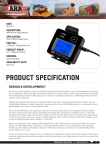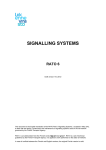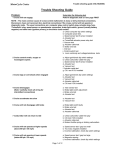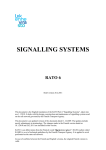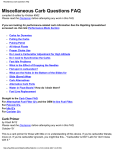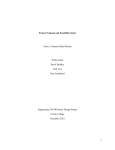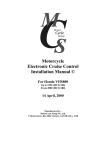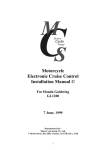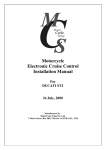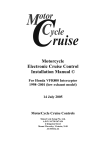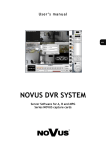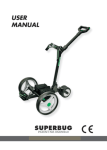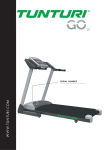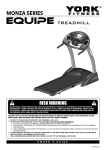Download Set up & User Manuals - Model specific single spool _MCSU4…
Transcript
otor M Cycle ruise Motorcycle Electronic Cruise Control Information, Set up & Operation Manual © (Sections 1~5 & 8~12) Refer to the Installation Manual for Sections 6 & 7 5 December 2005 MotorCycle Cruise Controls MotorCycle Setup Pty. Ltd. A.B.N. 94 798 167 654 6 Kingston Street Mount Waverley, Victoria, 3149 AUSTRALIA MCU400 CIU Single Spool ISOM MotorCycle Cruise © Electronic Cruise Control Information, Set up & Operation Manual © READ THIS FIRST The cruise control computer used has been purpose built for motorcycle applications. Testing has resulted in programming to deliver safe, reliable operation on a variety of motorcycles, from 250cc up. It is essential that you install the cruise control precisely in accordance with the advice in the installation instructions precisely so that electrical interference does not cause the unit to behave erratically or be rendered inoperative. We strongly recommend against fitting off-the-shelf motor car cruise controls to any motorcycle! WARNING: - This cruise will function properly only if your vehicle has resistor type (radio suppression) ignition wires (spark plug leads). The cruise control may not function properly if aftermarket SOLID CORE spark plug wires are installed. Please read Section 11, Safety Issues & Features before fitting & using the cruise control. If, after reading these instructions, you feel you are not competent to install this kit, we strongly urge you to seek the assistance of your local motorcycle dealer. NOTE: - It is recommended that on most motorcycles the fuel tank is less than 1/4 full before attempting to fit the cruise control. The fuel tank must be lifted for most installations and can be very heavy when full of fuel. NOTE: - If the bike is fitted with a flasher device or LED brake light globe on the brake light system, this may cause interference with the cruise control brake detection. If the cruise control will not work, try disconnecting the flasher device or replacing the LED globe with a conventional globe. Contact us for ways to enable both your brake light flasher or LED brake light and the cruise control. CONTENTS 1. 2. 3. 4. 5. INTRODUCTION WARNINGS , CAUTIONS AND NOTES TOOLS REQUIRED PARTS LIST OVERVIEW OF CRUISE CONTROL OPERATION Refer to the separate Installation Manual provided for your make and model of motorcycle for chapters 6 and 7. 6. PREPARING THE BIKE FOR CRUISE CONTROL INSTALLATION 7. INSTALLATION 8. DIAGNOSTIC MODE OPERATION 9. CALIBRATION, ADJUSTMENTS & ROAD TEST 10. SAFETY ISSUES & FEATURES 11. TROUBLE S HOOTING 12. LIST OF S UGGESTED INITIAL S ENSITIVITY S ETTINGS WARRANTY SHEET SET UP & CALIBRATION PROCEDURES SUMMARY SHEET ( LAST PAGE) 1 MotorCycle Cruise © 1. INTRODUCTION Congratulations, you have purchased one of the most advanced cruise control systems in the world - and one that is built specifically for motorcycles. All functions are microprocessor controlled, which reduces the complexity of installation. Before installing your cruise control, take the time to read and understand each step in this manual. Several steps are dependent on others, so it is important know where and how each component is to be mounted before installation commences. This manual covers the cruise control in general terms, and provides information about set up, calibration and adjustment of the cruise control. You will also find a separate installation instruction set that covers fitting the cruise control to your specific model of bike. 2. WARNINGS, CAUTIONS and NOTES This manual contains several cautions , warnings and notes, which are prominently displayed. The convention used is: A warning applies whenever injury could result from ignoring the warning; A caution applies whenever damage to the bike or cruise control could result from ignoring the caution; and A note applies where other aspects should be considered before any action to do with installation is undertaken. EXAMPLES: WARNING: - Always ensure the bike is properly supported on the side or centre stand and cannot accidentally fall off either stand. CAUTION: - Before drilling any holes, make sure there are no components that may be damaged on the other side of the surface being drilled. Double check for any wiring harness that might be easily damaged by a drill bit. NOTE: - Lay the wiring harness in place and connect the components before cable tying the harness in place. 3. TOOLS REQUIRED NOTE – not all of the tools listed will be required for your installation, but most will be necessary or very helpful to have at hand. • • • • • • • • • Socket and/or spanner, hex key set and screwdriver set to suit your motorcycle; Electrical Multimeter, Voltmeter or 12V test light (to check for electrical connections); Long nose pliers; A good quality flat file; (useful to install the control switch for most installations) A vice with soft jaws or a rag (useful to install the control switch for most installations); Side cutters (to cut cable ties); Loctite ‘243’ medium strength thread locking compound or equivalent; Electrical terminal ‘roll’ crimpers (to crimp electrical terminals supplied in the kit) Utilux No 61 and No 47A crimpers will cover almost all motorcycle terminals in the known universe! Soldering iron and electrical solder (where crimpers are not available or not useable) 2 MotorCycle Cruise © • • • • • 4. Hot air gun (to shrink heat shrink tube where required) We DON’T recommend the use of cigarette lighters! Roll of insulation tape; Silicon sealant to seal the cable slot in the Cable Interface Unit (almost any type of silicone sealant will do but black neutral cure sealant for windscreens is what we use); A bottle of VERY light oil such as sewing machine oil to lubricate the throttle cables, NOT ENGINE OIL OR MOTORCYCLE FORK OIL. THESE OILS ARE TOO HEAVY; A sharp kitchen straight edge carving knife or similar (this is to cut the foam computer mount block on some applications. ‘Stanley’ or other types of utility knives DO NOT cut foam well). PARTS LIST Check that all components depicted on the last pages of the separate INSTALLATION MANUAL are included in the cruise control kit. Please phone (03) 9808 2804 within Australia, international (61 3) 9808 2804, fax (61 3) 9808 2445 or e-mail [email protected] for advice, if any parts are missing; 5. OVERVIEW OF CRUISE CONTROL OPERATION The principles behind your cruise control's operation are very simple: • The computer continuously monitors the frequency of electrical pulses generated by the magnets passing the sensor or pulses generated from the motorcycle’s speedometer sender; • When the SET key on the switch is pressed, the computer stores the pulse frequency at the time in memory and then continuously adjusts the vacuum actuator, which controls the throttle to maintain the pulse frequency at the same figure to which it was set. If the frequency drops below the set frequency, the computer applies more throttle. If the frequency is above the set frequency, the computer releases the throttle. The key is that the computer monitors and reacts to changes very quickly and smoothly so that the speed effectively remains nearly constant. There are six major components in most installations: the computer, the vacuum actuator, the cable interface unit, the speed sensor, the switch and the loom. The functions of each are described below: • • • • • • The computer - monitors road speed, adjusts the throttle by controlling the vacuum actuator, monitors engine rpm, clutch and/or neutral detection, the brake system and the control switch for instructions from these components; the vacuum actuator - controls the throttle by pulling or releasing a cable which attaches to the throttle via the cable interface unit (CIU); the CIU - translates the motion from the throttle grip and the vacuum actuator to the throttle via a new cable supplied in the kit – most but not all installations use the CIU. Some have the actuator connected directly to the bikes carburettors or throttle bodies; The speed sensor - generates electrical pulses when the bike is in motion. In some installations the bike’s speedometer sender is used instead; The control switch - sends instructions from the rider to the computer; and The electrical loom - which connects the switch, the computer, the vacuum actuator, the sensor, the brake system, the clutch and or the ignition system. 3 MotorCycle Cruise © The cable interface unit is a new component developed and patented by MotorCycle Setup and is the key to safe cruise control operation on most motorcycles. An understanding of how it works should help you avoid making mistakes during installation. The following diagrams show the basic assembly procedure and operating principles of the cruise control Cable Interface Unit (CIU). NOTE: - The actual entry points of cables and the direction of rotation may differ depending on the model of the motorcycle, but the principles involved remain the same. Specific assembly instructions are provided in your specific hardware kit. In order to improve the clarity of the diagrams, the multiple holes in the dual spool have been omitted, with only the actual holes used for the cable nipples being shown. 1st step. Actuator cable CIU housing Actuator spool Bush The actuator spool is installed in the CIU housing with the actuator cable. The actuator spool is rotated to fully extend the cable. 2nd step. Roll pin in carburettor spool Carburettor spool The carburettor cable and spool are installed and the other end of the carburettor cable is attached to the carburettor or fuel injection throttle bodies. Note the position of the roll pin. It is nearly contacting the end of the groove in the actuator spool. The free play in the carburettor cable must be adjusted so that the cable outer can be pulled out 0.5 ~ 1mm before the throttles start to open. This ensures that the cruise control cannot prevent the throttles returning to idle. If more free play is allowed the response of the cruise control is compromised. This adjustment of free play is usually performed after final assembly of the CIU is completed and the CIU is in its final location. This is because flexing the cable does affect the free play. It is shown at this stage in these Carburettor cable 0.5 ~ 1 mm 0.020" ~ 0.40" diagrams to improve clarity. 4 MotorCycle Cruise © After this adjustment is performed, the carburettor cable adjustment MUST NOT BE MOVED. All future adjustments of free play in the throttle grip must be performed on the throttle cable from the throttle grip. If incorrect free play in the carburettor cable is suspected due to inconsistent cruise operation or because of inconsistent idle speed, the adjusters on the throttle cable from the hand grip must be backed all the way off to give as much free play as possible. If this does not result in AT LEAST 5mm of free play in the throttle cable, the throttle cable must be removed from the handgrip or CIU before adjustment of the carburettor cable is attempted. This is crucial because the amount of free play in the throttle cable also affects the apparent free play in the carburettor cable. 3rd step Throttle grip cable The throttle cable and spool are installed. Note that the throttle spool and the actuator spool both have identical grooves in them. These grooves engage the roll pin in the carburettor spool (the centre spool). Throttle spool Normally the end cap and retaining nut would be installed at this point. These items are not shown in order to improve clarity. Normal throttle operation Throttle grip is twisted pulling cable Roll pin in carburettor spool is pulled around by the end of the groove in the throttle spool Carburettor cable opens carburettors Actuator spool does not move During normal operation of the throttle, twisting the throttle grip pulls the throttle cable. This pulls on the throttle spool and rotates it. The end of the groove contacts the roll pin in the carburettor spool, and the carburettor spool rotates, pulling the carburettor cable and opening the throttles. Because the roll pin is free to move in the groove in the actuator spool, this spool does not move. This reduces friction in the throttle system and prevents any possibility of jamming due to cables buckling when being pushed. 5 MotorCycle Cruise © Cruise operation Actuator cable is pulled by actuator Throttle spool does not move Carburettor cable opens carburettors During cruise operation the actuator cable pulls the actuator spool and rotates it. The end of the groove contacts the roll pin in the carburettor spool, rotating the spool and pulling the carburettor cable. As the cruise control applies and releases the throttle the rider will notice the amount of free play in the throttle grip will vary. If the throttle grip is twisted open while the cruise control is engaged the rider over-rides the cruise control. When the throttle is released, the cruise control will resume control, unless it has been disengaged by brake operation or if the motorcycle exceeds the current set speed by 150% such as during an overtaking manoeuvre. The cruise will also disengage if the speed drops to 75% of set speed such as when riding up hill. This is unlikely to occur on large capacity motorcycles. 6 MotorCycle Cruise © 6. PREPARING THE BIKE FOR CRUISE CONTROL INSTALLATION Refer to the separate installation instructions provided for your make and model of motorcycle. Specific instructions for this will be provided in your ‘model specific’ parts kit, however usually the following components will have to be removed from most bikes and the following operations performed. • • • • • • Saddlebags (if fitted). The seat. Side covers. Fuel tank (not always necessary, but usually is). Some fairing parts (if fitted). The ‘pull’ or opening throttle cable will have to be disconnected from the carburettors or throttle bodies. Sometimes you will have to disassemble the throttle twist grip first in order to disconnect the throttle cable at the other end. This should be done anyway so that you can lubricate the twist grip and throttle cables (see below). On many models you may also have to remove the air filter housing (air box) in order to disconnect the throttle cable. NOTE: - In some cases, the pull cable is disconnected at the throttle grip end only, and NOT removed from the carburettors or throttle bodies. • Disconnect the battery negative lead. Lubricating the throttle cable and throttle twist grip. NOTE: - this is essential maintenance to ensure smooth operation of the cruise control and throttle grip. • Undo and remove the right handlebar end weight (if fitted). • Remove the screws clamping the right switch block/throttle hand grip/cable assembly to the handlebar. • Disconnect the cables from the twist grip. • Remove the twist grip from the handlebar and clean the inside of the twist grip and the handlebar. • Apply a THIN film of engine oil to lubricate the throttle grip barrel where it contacts the handle bar. • Run several drops of light oil (sewing machine oil is ideal – DO NOT USE ENGINE OIL. It is too heavy!) down each throttle cable. • Re-assemble the twist grip/cable/switch block assembly. • Replace the handlebar end weight (if fitted). Use a medium strength thread lock compound on the threads of the bolt. 7. INSTALLATION Refer to the separate Installation Manual provided for your make and mode l of motorcycle. 7 MotorCycle Cruise © 8. DIAGNOSTIC MODE OPERATION Diagnostic mode operation is used to confirm correct electrical and mechanical installation before actually riding the motorcycle. During diagnostic mode operation the speed control programme is disabled, and correct operation of most parts of the cruise control can be checked in safety while the bike is stationary. Confirmation that electrical connections are correct is provided by the indicator light on the control switch and by the GREEN indicator light on the front of the computer (next to the loom plug). Note: - The control switch has an indicator light at the right end, next to the ON-OFF button. This light has two colours, RED and GREEN and produces YELLOW when both red and green are on. RED indicates power on. YELLOW indicates cruise control engaged. GREEN is used to confirm the cruise control functions during the diagnostic checks and some calibration procedures. There are also two lights on the front of the computer, one each side of the loom connector. One is green, the other is red. During the diagnostic checks many of the features of the cruise control are confirmed by the GREEN light on the CONTROL SWITCH and the GREEN light on the COMPUTER operating. For example, the lights confirm brake switch operation. After applying the brakes in diagnostic mode, WAIT AT LEAST ONE SECOND BEFORE PERFORMING ANY OTHER OPERATION as the lights may stay on for up to one second after the brakes are released. While in diagnostic mode the RED light on the COMPUTER is used to confirm correct tach sensing connection. During normal operation the RED light on the COMPUTER displays stop (error) codes and is only used to diagnose problems. See your trouble-shooting guide for more details on this function. • Place the bike on the centre stand (if it has one) and make sure it is in neutral. • Turn the bike’s ignition switch OFF • Make sure that the bike’s engine kill switch is ON (engine RUN position). • Press and hold the SET and ON-OFF buttons. • Turn ON the bike's ignition switch - DO NOT START the engine. • The cruise control is now in diagnostic mode. • Check that the bike is in Neutral. If not, select Neutral (the indicator light MAY come on green. Ignore it for the moment). 8 MotorCycle Cruise © Testing the brake system • Operate the rear brake pedal a few times. The indicator light on the cruise control switch should illuminate GREEN and the light on the front of the computer should illuminate green when the pedal is depressed and go out when it is released. Adjust the rear brake light switch so that the light comes on just before the brakes start to operate. NOTE: - If the brake switch is already ON (it is adjusted so that the switch never turns OFF or the switch is stuck on), then the light on the control switch will NOT COME ON AT ALL. The brake light switch must be OFF before applying the brake in order for the control switch light to work. If you cannot get the light to come on, check that your brake lights are not permanently on, and that they do actually work with brake application. If they are stuck on, back off the brake switch adjuster to ensure that the switch DOES TURN OFF. If the brake light globe is blown the light will not come on. In many cases if you have fitted an LED brake light or a brake light flasher system, this will prevent the cruise control detecting brake signal. THE CRUISE CONTROL WILL NOT WORK UNTIL THESE PROBLEMS ARE CORRECTED. • Operate the front brake lever and the rear brake pedal a few times. The light on the switch should illuminate green when the brakes are used. This indicates that the cruise control will cancel when the brakes are applied. NOTE: - If the bike is fitted with a flasher device on the brake light system this may cause interference with the cruise control brake detection. If the cruise control will not work, try disconnecting the flasher device. Contact us for ways to enable both your brake light flasher and the cruise control. Testing the control switch and actuator solenoids • Depress the SET button. The switch light will go green and a click should be heard from the actuator each time the button is pressed. This indicates that both the SET button and the vacuum solenoid in the actuator are working correctly. • Depress the RES button. The switch light will go green and a click should also be heard from the actuator, but will sound a little different, as the RES button controls the dump solenoid, whereas the SET key controls the vacuum solenoid, and it sounds a little different. This indicates that both the RES button and the dump solenoid in the actuator are working correctly. • Press the ON-OFF switch. The switch light will go green when the button is pressed and go out when it is released. This indicates that the ON-OFF switch is working correctly. Testing the actuator and vacuum • Pull on the brake lever (to ensure that the actuator is reset and the engine will idle), release the brake and start the engine. • Press the SET key several times until the engine revs start to increase. Each press will increase the speed slightly. NOTE: - there will be some delay with this operation. It will take several presses (10~20) before the engine speed starts to increase. If the engine speed gets too high, the brake lever or the ignition switch will disengage the actuator. The engine kill switch will turn the engine off BUT MAY NOT RELEASE THE THROTTLE as the throttle actuator may still be engaged if the kill switch does not remove power to the brake light system. OPERATE THE BRAKE LEVER TO TURN THE ACTUATOR OFF AND RELEASE THE THROTTLE. 9 MotorCycle Cruise © NOTE: - The ignition switch will turn the speed control off. This will also release the cruise from diagnostic mode. You will need to press and hold the SET and ON-OFF buttons while turning the ignition switch back ON to place the cruise in diagnostic mode again. Depress the brake lever to reset the actuator before restarting the engine and repeating the previous step. • Press the RES key several times (5~15 presses before the engine revs will start to drop) and the engine should gradually return to id le. o Operate the brakes to reset the actuator. Testing tach (engine over rev) sensing • Observe the RED light on the COMPUTER and rev the engine a few times using the throttle. The red light should be flashing regularly and the flash rate should vary with the engine revs. In most cases, with the engine idling the flash rate will be around 2 flashes per second, but this may be different for different models. Testing the speed sensor WARNING: - MAKE SURE THAT THE BIKE IS SECURE ON THE CENTRE STAND, AND THE REAR WHEEL IS CLEAR OF THE GROUND BEFORE PROCEEDING WITH THE NEXT STEP. NOTE: - This test can only be done on the centre stand if the speed sensor is fitted to the rear wheel or the bike’s speedometer sender is driven from the gearbox or rear wheel. If the speed sensor is on the front wheel or the bike’s speedometer sender is fitted to the front wheel, this test must be either skipped or performed while riding the motorcycle. • Engage 3rd or 4th gear and GENTLY release the clutch. Use the throttle to increase engine speed to about 1500~2000rpm. Watch the indicator light on the switch. The light should flash as the computer detects the speed signal. The pulse rate will very depending on the speed signal input. If an MCS speed sensor was fitted to the bike during installation, the flash rate will be fairly slow and may not work until the wheel speed is 30~40 kph (20~25 mph) or greater. If the bike’s speedometer sender is used, the flash rate may be very slow or more likely fairly or very fast, but will work at very low speeds as well. The faster the speed, the faster the pulse rate from the light. This indicates that the computer is detecting the speed signal. The green indicator light on the computer will also flash. WARNING: - DO NOT ATTEMPT TO ENGAGE THE CRUISE CONTROL WHILE THE BIKE IS ON THE CENTER STAND. THE CRUISE CONTROL WILL NOT WORK WITHOUT THE MASS OF THE BIKE BEING DRIVEN BY THE REAR WHEEL. THE CRUISE CONTROL WILL APPLY THROTTLE IF THE SET KEY IS PRESSED AND THIS MAY UNSETTLE THE BIKE ENOUGH TO DISLODGE THE CENTRE STAND. 10 MotorCycle Cruise © Testing and configuring the clutch/neutral sensor (if connected) NOTE: - Because the bike’s clutch, neutral, side stand and starter lockout circuits are often all linked together, this test is best done with the bike on the centre stand (if fitted) with the side stand up, and the bike in gear. If the side stand is down and the bike is in neutral, it may not be possible to configure and test this feature. NOTE: - The polarity (12V or 0V) of the clutch sensor is configurable. This section is to configure and test this feature. • Operate the clutch lever. The indicator light on the switch may illuminate green when the clutch is disengaged and go out when it is released. • If the light does come on WHEN THE CLUTCH LEVER IS PULLED IN, AND GOES OUT WHEN THE LEVER IS RELEASED, the test is complete. If it does not come on at all OR comes ON WHEN THE CLUTCH LEVER IS RELEASED, move to the next step. • Press and hold the ON-OFF button and then press the SET button. The indicator light on the switch should come on RED. Release both buttons. This sets the neutral sensor to high (12V) detection. • Operate the clutch lever. • If the indicator light comes on green WHEN THE CLUTCH IS PULLED IN and goes out when the clutch is released, the test is complete. If it does not, move to the next step. • Press and hold the ON-OFF button and then press the RES button. The indicator light on the switch should come on YELLOW. Release both buttons. This sets the neutral sensor to low (0V) detection. • • Operate the clutch lever. If the indicator light comes on green WHEN THE CLUTCH IS PULLED IN and goes out when the clutch is released, the test is complete. If it does not come on at all you may have connected the clutch sensor wire to the wrong terminal of the clutch switch, the clutch switch may be faulty (not uncommon) or it may be necessary to have the engine running during this test. Try reconnecting the wire to the other terminal on the clutch switch and then repeat the above test. NOTE: - If the clutch switch is faulty or for any other reason you cannot get the clutch switch to configure, it is VERY likely that the clutch switch connection will prevent the cruise control from working. If you cannot configure the clutch sensing and the cruise control will not work, you may have to disconnect the clutch sensor wire from the clutch switch. Refer to the last page of the Trouble Shooting Guide , ‘Diagnostic stop (error) codes’. If the cruise control will not engage due to a code 7 (neutral/clutch sensor fault), this indicates that the clutch switch cannot be configured, is configured incorrectly, is connected incorrectly or is faulty. You may have to disconnect the clutch sensor wire to enable the cruise control to operate, until the error can be corrected. WARNING: - BE VERY CAREFUL TO ENSURE THAT THE REAR WHEEL IS CLEAR OF THE GROUND IF YOU INTEND TO TEST WITH THE ENGINE RUNNING, AS IN MOST CASES THE BIKE MUST ALSO BE IN GEAR TO TEST THE CLUTCH SWITCH. 11 MotorCycle Cruise © Checking the carburettor cable free play. • Pull on the brake lever (to ensure that the actuator is reset and the engine will idle), release the brake and start the engine (if the engine is not already running). • Press the SET key several times and count the number of times you press SET until the engine revs start to increase. Each press will ‘pull the actuator and take up the free play in the cables. • It should take 12~20 presses before the engine revs start to rise. NOTE: - This number is a function of the carburettor cable free play AND the amount of vacuum the engine produces. Some bikes have sufficient vacuum for the engine revs to start to rise within 12 presses when the carburettor cable free play is set at around 0.5mm. Most will require 15 to 20 presses. A few will require more, but NONE should require more than 25 presses of the SET key. NOTE: - there will be some delay with this operation. It will take several presses (10~20) before the engine speed starts to increase. If the engine speed gets too high, the brake lever or the ignition switch will disengage the actuator. The engine kill switch will turn the engine off BUT MAY NOT RELEASE THE THROTTLE as the throttle actuator may still be engaged if the kill switch does not remove power to the brake light system. OPERATE THE BRAKE LEVER TO TURN THE ACTUATOR OFF AND RELEASE THE THROTTLE. NOTE: - The ignition switch will turn the speed control off. This will also release the cruise from diagnostic mode. You will need to press and hold the SET and ON-OFF buttons while turning the ignition switch back ON to place the cruise in diagnostic mode again. Depress the brake lever to reset the actuator before restarting the engine and repeating the previous step. • Apply the brakes to release the actuator and return the engine to idle. • Repeat the above procedure two or three times to confirm the number of presses of the SET button required to take up the free play. • If the number is less than 20, and the engine returns to idle reliably when the brakes are operated, your carburettor cable adjustment is correct and the vacuum levels are good. • If the number is more than 20 and less than 25, you should check the carburettor cable adjustment again. It may have too much free play. If the free play appears to be OK (around 0.5 ~1.0mm) then you ma y need to check for vacuum leaks, a faulty vacuum stop valve in the actuator vacuum hose or use a vacuum gauge to check the vacuum levels. NOTE: - Most engines should have about 30~50cm Hg (cm of mercury) or about 12~20 inches Hg (inches of mercury) at idle. Some might have more, but normally there should not be less. If you check the vacuum at the actuator, the vacuum level should be stable (not pulsing) as the vacuum stop valve will keep a constant vacuum in the hose. If you check at the balance port (before the vacuum stop valve) the vacuum will pulse with each inlet stroke of the motor. NOTE: - IF the number is greater than 25, you will need to adjust the carburettor cable and/or check vacuum, as this is not a satisfactory result and will impact severely on the performance of the cruise control. • Most bikes adjusted correctly and in good tune, return a number of 15~18 presses. 12 MotorCycle Cruise © • Turn the ignition switch off. This completes the diagnostic test procedure. Re-assemble the motorcycle for road testing CAUTION: - Check that no wires and control cables are crushed or caught by any of the fairing panels, seat or the fuel tank during re -assembly. Check that all wires and cables are restrained and will not be damaged by any moving or stationary parts. Check that the seat will not damage the wiring harness or computer. 9. CALIBRATION, ADJUSTMENTS & ROAD TEST Since the brakes are the fastest way to turn the cruise control off, it is ESSENTIAL that they be adjusted optimally to suit the rider AND that they activate the rear brake lamp as quickly as possible. It is recommended that both front and rear brakes be set up so that the brake lamp turns on as early as possible when either brake is applied. Naturally you have to ensure that the brake lamp does turn off - otherwise the cruise control will not work at all. Careful adjustment of the foot brake lever so that the rider's foot does not have to lift up to reach it is recommended. Next, adjust the brake switch so that it turns on with very little movement of the brake pedal. Repeat this process with the front brake lever if adjustment is available. WARNING: - If there is any evidence of inconsistent operation or sticking of either brake light switch, replace the switch. The brake light switches are the main components used to disengage the cruise control. It is recommended you adjust the rest position of the gear lever to match the foot brake lever for optimum rider comfort. NOTE: - If the rear brake light filament or fuse breaks, or the brake light is on, the cruise control will not work at all. If your cruise control appears not to be working, these are the first things to check. CALIBRATING AND ADJUSTING THE CRUISE CONTROL NOTE: - In most cases, the computer will already be supplied configured for your bike. If this is the case there will be a label on the side of the computer stating what model it is configured for. This configuration is based on our tests with a similar bike to yours. You may be able to improve the performance of the cruise control by performing the calibration procedures, or the performance may be satisfactory as supplied. NOTE: - IF YOUR COMPUTER IS ALREADY CONFIGURED FOR YOUR BIKE, YOU CAN ROAD TEST IT NOW WITHOUT PERFORMING THE CALIBRATION PROCEDURES. IF AFTER ROAD TESTING, YOU FEEL THAT THE PERFORMANCE COULD BE IMPROVED, YOU MAY PERFORM ANY OR ALL OF THE CALIBRATION PROCEDURES. NOTE: - If the computer has a label on the side stating that it is ‘Not Configured’, you will have to complete the calibration and adjustment. NOTE: - The following pages discuss in detail the procedures required to calibrate the cruise control. There is also a single page sheet at the back of this manual that shows the steps required in brief. READ the procedure detail first, then use the single sheet as a memory jogger when out doing the calibration. 13 MotorCycle Cruise © There are several steps that must be performed to ‘tune’ the cruise control to your motorcycle. They are: • Initial adjustment of the sensitivity or ‘gain’. This function allows you to select how ‘firmly’ you want the cruise control to control the speed and tailors the cruise control’s response to your motorcycle. We suggest an initial setting in order to speed up the adjustment process. This should be set to our recommended settings before you perform the other calibration procedures, because these settings do interact to some degree. • Calibrate the speed sensor pulse rate. This function teaches the cruise control computer how many pulses per wheel revolution it will receive from the speed sensor or the bike’s speedometer sender, so that the cruise control knows what speed the bike is doing. This must be done while riding the motorcycle at 70 kph (45 mph). • Calibrate the initial throttle pull. This function teaches the cruise control computer how much throttle to apply when you first engage the cruise control so that the speed does not ‘push’ or ‘lag’ too much when the cruise is engaged. This must be done while riding the motorcycle at 70 kph (45 mph). • Adjust the sensitivity or ‘gain’. This function allows you to select how ‘firmly’ you want the cruise control to control the speed and tailors the cruise control’s response to your motorcycle. NOTE: - You will need a section of road that is relatively flat (no hills) on which you can safely ride at 70kph (45mph) to perform the speed sensor and initial throttle pull calibrations. Most cities and towns have major arterials or freeways (interstates) where this is possible without having to travel too far. In order to perform the initial throttle pull calibration you need to be able to engage the cruise control continuously on flat ground for 5 seconds at a time. You will probably need to do this at least 3 times and maybe up to 5 times to get a good result. We use a flat section of a dual lane road that is about 400m (1/4 mile) long with a median strip that allows us to do a ‘U’ turn at each end. A full calibration from scratch can usually be performed in two ‘laps’. Initial Sensitivity Adjustment The sensitivity adjustment has 15 settings and the cruise control uses the indicator light on the switch and green light on the computer to ‘flash’ this number, 1 through to 15. It will flash the number of times corresponding to the sensitivity number, pause for a few seconds and then flash the number again. One (1) is the lowest setting and might be used on VERY powerful bikes such as a Honda CBR1100XX Blackbird or Suzuki GSXR1300 Hyabusa (CBR1100XX usually works best on a setting of 4), while 15 is the highest setting and would be used on small capacity bikes such as 250cc scooters or mid range bikes that are pulling a side car or trailer. Large capacity cruisers usually use high numbers too, as they usually have very gentle throttle response. Bikes in between would use numbers in the middle of this range. We have provided a table of suggested settings for specific models as we set up the cruise control on these models. You will find this in Section 12 of this manual (on page 20). If you don’t have a specific kit for your bike, you will be able to guess an initial setting by comparing the settings we have suggested for other similar bikes. • Turn the ignition switch OFF. Press and HOLD the RES button ONLY, turn the ignition switch ON, release the button. The switch indicator light will come on RED and start to flash YELLOW. The cruise control is now in sensitivity adjustment mode. 14 MotorCycle Cruise © • The indicator light will flash yellow about 1 flash per second, then pause for a few seconds and flash the number again. The sensitivity number should be 1 on a new computer, unless the computer is preconfigured for a specific model. • Refer to the Cruise Control Model Sensitivity list supplied with the cruise control and select an appropriate sensitivity number for your bike. • Press the SET button to increase the number or press the RES button to reduce number. Each press will change the number by one. Count the flashes to confirm the setting. • Turn the ignition switch OFF. This completes the initial sensitivity adjustment. Speed Sensor Pulse Rate Calibration • Turn the ignition switch OFF. Press and HOLD the RES and ON-OFF buttons, turn the ignition switch ON, release the buttons. The switch indicator light will come on GREEN. The cruise control is now in speed pulse rate calibration mode. • Ride the bike at 70 kph (45 mph) and hold the speed STEADY. The GREEN indicator light will be flashing as you ride the bike. The flash rate will vary with the bike’s speed and the frequency of the pulses coming from the speed sensor, so the flash rate may be very slow or very fast. • Press and release the SET button once. The indicator on the switch will change to RED for two seconds and may flash yellow during this time. The computer will record the pulse rate of the speed signal. Hold the speed STEADY at 70 kph (45mph) for two seconds until the red light goes out. The light will resume flashing green from the speed signal after the red goes out. • If you are not sure that your speed was correct or stable, adjust you speed to 70 kph (45 mph) again and simply press SET aga in. Each time SET is pressed the speed pulse rate will be recorded and saved overwriting the previous setting. • Stop the bike and turn the ignition switch OFF. This completes the speed signal pulse rate calibration. Initial Throttle Pull Calibration NOTE: - We STRONGLY recommend that you perform a Speed Sensor Pulse Rate calibration FIRST before performing the Initial Throttle Pull calibration even if the computer is pre -configured for your bike. • Turn the ignition switch OFF. Press and HOLD the SET button ONLY, turn the ignition switch ON, release the button. The switch indicator light will come on GREEN. The cruise control is now in initial throttle pull calibration mode. • Ride the bike at 70 kph (45 mph) and hold the speed STEADY (this procedure will not work it the speed is below 65kph (42mph) or above 75kph (48mph). The GREEN indicator light will be on steady as you ride the bike. 15 MotorCycle Cruise © • Press and release the SET button THEN release the throttle a fraction of a second (about ½ a second is ideal) AFTER pressing the SET button. The computer will apply a small amount of throttle and the GREEN light on the switch will go out. The bike may hold speed, decelerate or accelerate depending on how responsive to throttle and how powerful the bike is. DO NOT APPLY THROTTLE OR BRAKES TO STOP EITHER ACCELERATION OR DECELERATION. Let the bike slow down or speed up without applying throttle OR brakes. NOTE: - You may apply the brakes BEFORE the 5 seconds are up (if you are blocked by another vehicle for example). This will have NO effect on the calibration at all, but the result will also NOT be recorded. • After 5 seconds the green light will come back on and the throttle will be released. • Apply throttle to move the speed back to 70kph and hold it STEADY. • Press and release the SET button and then release the throttle again. The bike’s acceleration or deceleration should be less than before. • Wait 5 seconds for the light to come back on and the throttle to be released then ride back to 70kph again. • After performing this routine 3 to 5 times, the bike’s speed should hold stable at 70kph after you have pressed SET. Small bikes that use a lot of throttle may take more attempts to get right. Very powerful bikes may take a few attempts to get a consistent result. HINT: - If you are having difficulty getting a consistent result, check that you are holding the speed very steady with the throttle just before pressing the SET button, and that you are not releasing the throttle before the cruise control has applied throttle. You MUST wait at least ½ second after pressing SET before you release the throttle. If the transition from YOU holding the throttle to the CRUISE CONTROL holding the throttle is not seamless, the calibration may not work accurately. This effect will be much more pronounced on very powerful motorcycles. • • You can repeat this procedure as many times as you want and at any time you want to re-calibrate the initial throttle pull. If you have changed the loads on the bike (pulling a trailer for example) you may want to recalibrate the initial throttle pull to compensate. Stop the bike and turn the ignition switch OFF. This completes the initial throttle pull calibration. HINT: - If after using the cruise control you feel that the initial throttle pull is too light or too strong for your personal taste, you can ‘trick’ the cruise control by performing the initial throttle pull calibration on slight hills. If you want a more GENTLE throttle application, calibrate the cruise control initial throttle pull on a slight DOWN hill. If you want a STRONGER throttle application calibrate the cruise control initial throttle pull on a slight UP hill. NOTE: - The initial throttle pull calibration will have a very small effect on how the cruise control works AFTER it is engaged. It mainly affects how much throttle the cruise control applies initially when the SET or RES buttons are pressed. 16 MotorCycle Cruise © Final sensitivity adjustment • Turn the ignition switch OFF. Press and HOLD the RES button ONLY, turn the ignition switch ON, release the button. The switch indicator light will come on RED and start to flash YELLOW. The cruise control is now in sensitivity adjustment mode. • The indicator light will flash yellow about 1 flash per second, then pause for a few seconds and flash the number again. The sensitivity number should be 1 on a computer that is not configured or may be set to a suitable number for your bike already. • Ride the motorcycle at various speeds and press SET to engage the cruise control. The RES button does not work to engage the cruise control in this mode. Use the brake to disengage the cruise control and ride to a different speed, then press SET to engage the cruise control again. • The cruise control should control the speed smoothly and without too much ‘wander’ in the speed. • If the cruise control is too abrupt or hunts (applies and releases the throttle continuously) you will need to reduce the sensitivity number. • If the speed wanders too much and the response from the cruise control is slow you will need to increase the sensitivity number. • Press the SET button to increase the number or press the RES button to reduce number. Each press will change the number by one. You can make these adjustments either while riding with the cruise control engaged or with the bike stopped. If you are stationary, each press of SET or RES will adjust the sensitivity. If you are riding between 35 kph and 180 kph, the first press of the SET button will engage the cruise. The RES will not work until the cruise control is engaged while moving. After the cruise control is engaged, the SET and RES buttons will adjust the sensitivity. • Stop the bike and turn the ignition switch OFF. This completes the initial sensitivity adjustment. HINT: - The cruise control may ‘hunt’ on down hill sections as the cruise control tries to balance throttle against speed. This will be more pronounced at lower speeds where very small amounts of throttle movement can cause large changes in speed. This will apply particularly if the throttle is wound all the way off to idle position and then re-applied. You will need to balance the sensitivity number with the performance you want from the cruise control in different circumstances. It may take some time for you to become accustomed to the cruise control and achieve a final setting that you find suitable for all situations. Large changes in load (towing a trailer) may also require a change in the setting. NOTE: - Large changes in the sensitivity number (up or down by more than 2 steps) may require you to re-calibrate the initial throttle pull again. The sensitivity settings do interact with the initial throttle pull settings to some degree. NOTE: - You can ONLY adjust the sensitivity when stationary OR with the cruise control engaged while riding. It is NOT possible to adjust the sensitivity while you are moving without the cruise control engaging first. 17 MotorCycle Cruise © Road testing the cruise control Start the bike. To turn your cruise control ON, press the ON-OFF button once. The indicator light will come on RED to indicate power is ON. To turn the cruise control OFF, press the ON-OFF button again. The red indicator light will go out. The light is reasonably bright, but will not be visible in full sunlight. When riding, pressing the SET or RES buttons will engage the cruise control and the indicator light will turn yellow. If the bike’s ignition switch is turned OFF, the cruise control will turn OFF. When the bike is started again next time, the cruise control will be OFF and SET or RES will NOT work. Press the ON-OFF button to turn the cruise control back ON (red indicator light will come on) to enable the SET and RES buttons. • Press the ON/OFF switch once to turn the cruise control ON (red light ON); • Ride the bike to 60kph (35mph) and press the SET key. The cruise control should engage and smoothly maintain speed; • Depress one of the brake levers to turn the cruise control off; • Use the throttle to accelerate the bike up to 80kph (50mph) and press the SET key. The cruise control should engage and smoothly maintain speed within 2kph (about 1.5mph); • Press the SET key 5 times. The cruise control should smoothly increase the speed by about 10 kph (6mph). • Press the RES key 5 times. The cruise control should smoothly decrease the speed by about 10 kph (6mph). • Apply the brakes and slow down to about 60 kph (35mph). Press the RES key once. The cruise control should engage and smoothly accelerate to the previous SET speed and maintain speed within 2kph (about 1.5mph). Testing the clutch and/or tach sensor. The clutch and/or tach sensor may be road tested by setting the cruise on a suitable speed (ie. 60kph or 35 mph) while on a level road or slight uphill, and pulling in the clutch. The engine will rev higher initially but should drop quickly (within 1/2 second) back to idle. If this takes longer than this, check that there is no excess friction in the throttle mechanism that is slowing down the throttle and not allowing it to ‘snap’ shut or your clutch switch (if fitted) may be faulty or the clutch sensing not configured correctly or the tach sensor may not be connected. Ideally, BOTH of these items should be connected and working. This completes the testing & adjustment procedure. 18 MotorCycle Cruise © 10. SAFETY ISSUES & FEATURES Electrical ‘Noise’. Noise is a broad term used to describe the electromagnetic radiation of energy. Noise is generated during rapid changes in voltage or current levels or by radio transmitters (ignition systems, alternators, mobile phones and other heavy current carrying wires). If noise gets coupled into the cruise control wiring harness it can create disturbances within the cruise control computer. The cruise control may drop out after engagement or not engage at all, but still pass all diagnostic tests. The most likely causes of electrical noise interference on a motorcycle is faulty spark plug leads or fitment of non suppressed spark plug leads, or the electrical system could be in poor repair due to age or lack of appropriate preventative maintenance. WARNING: - It is ESSENTIAL that the spark plug leads are radio suppression type leads and that they are in good condition. Inspect the spark plug leads for any cracks, and replace if required. All original equipment high-tension ignition leads, in optimal condition, should be acceptable, but the cruise control MUST NOT BE USED IF AFTERMARKET, SOLID CORE HIGH TENSION LEADS ARE FITTED. Ideally all cruise control wiring should be kept as far as possible from all high voltage and high current wiring. This is often difficult to achieve on a motorcycle due to space limitations, so it is important to FOLLOW THE WIRING HARNESS INSTALLATION INSTRUCTIONS CAREFULLY. Make sure that the bike’s battery and charging system are in good condition and the battery electrolyte levels are correct and the battery connections are clean and tight. The battery acts as an electrical ‘buffer’ and absorbs electrical spike energy and stabilises voltage in the electrical system. CruiseSafe actuator cut off. As an additional safety measure, MotorCycle Setup has developed a new component for use on motorcycle cruise controls; the CruiseSafe cut off. The MotorCycle Setup ‘CruiseSafe’ actuator cut off cuts power to the cruise control throttle actuator (throttle servo) whenever the brake is applied. This inno vative safety device is unique to the MCS product range and demonstrates the company’s dedication to building product to the highest possible levels of safety, quality and reliability. The ‘CruiseSafe’ cut off is a simple switch incorporated into the brake circuit so that when the brake light switch operates, power to the cruise control actuator is shut down. WARNING: - In order to stop the motorcycle in the event of cruise control electrical malfunction, simply pull on the brakes. This will remove power to the cruise control actuator after approx ½ second delay. WARNING: - In the event of a major malfunction, the cruise control may re-apply the throttle when the brakes are released. If this occurs, disconnect the loom computer plug from the cruise control computer until the cause can be found and remedied. 19 MotorCycle Cruise © WARNING: - Any erratic behaviour (cruise control disengages at random or it fails to engage without resetting by turning the ignition switch off and back on) from the cruise control should be regarded as suspicious. The cruise control computer should be disconnected until the cause can be found and remedied. The ‘CruiseSafe’ protects you against accidental damage to the wiring loom or any sort of electrical failure or interference in the cruise cont rol electronics causing a malfunction, because whenever the brakes are applied, the cruise control actuator is disconnected from power. Its operation is failsafe, which means that it if you lose power to the brakes, the brake light globes blow, a wire becomes disconnected or the ‘CruiseSafe’ fails, the power to the cruise control actuator is disconnected. The ONLY electrical failure it cannot protect against is if the brake light switch/s fail. Then you must turn the cruise control and the bike OFF using the bike’s engine kill switch or ignition switch to kill the engine. MotorCycle Setup has chosen to use a mechanical switch instead of an electronic device, because electrical interference cannot hinder its operation. Other safety features. The cruise control can be shut off by any of the following methods: • • • • • • • Applying the brakes; Pulling in the clutch (as long as clutch and/or tach sensing are connected); Pressing the ON/OFF button to OFF; Accelerating to 150% of the SET speed or exceeding the maximum speed; Decelerating to 80% of the SET speed or running under the minimum speed (35kph, 22mph); Turning the engine kill switch OFF (this stops the engine but may NOT turn off the cruise control); Turning off the ignition key. The cruise control will disengage if any of the connectors become separated, if the brake light filament breaks or the brake light system loses power - for example if a fuse blows. There are numerous safety features designed into the computer and throttle actuator to ensure that should one or more components fail there is still a way to turn off your cruise control. For safe riding NEVER operate this cruise control on steep slopes with very heavy loads on the bike. WARNING: Your cruise control is designed with numerous safety features, but only the motorcycle KILL SWITCH or the IGNITION KEY can overcome a runaway condition caused by a tangled or jammed carburettor linkage. Our patented Cable Interface Unit has been specifically designed to eliminate the possibility of such an event. Without it, it is virtually impossible to SAFELY fit a cruise control to most motorcycles. Regular inspection of control cables is recommended to prevent jamming of the throttle, which could occur if cables were frayed or damaged. 20 MotorCycle Cruise © 11. TROUBLE SHOOTING A potential source of problems is electrical interference. Your kit has been developed based on testing to avoid this type of problem by installing the loom and computer in unaffected areas. However, as the speed rises the electrical fields generated by the bike increase. Also, older bikes tend to produce larger electrical fields from old spark plug leads or coils. If you experience this type of problem, check that you have followed the installation instructions precisely. Correct any obvious mistakes. If the problem persists call MotorCycle Setup for advice. As a last resort, we will refer you to our local installer if you are prepared to pay for him to check the installation and follow his recommendations. If our dealer/installer network is unable to make the unit work properly, you will receive a full refund of the cost of the cruise control (NOT including freight) on return of the kit. If the cruise control was purchased through a dealer (or other third party) it must be returned via that third party. There is a separate trouble-shooting guide supplied with the kit. Refer to the trouble-shooting guide for detailed problem diagnosis. The most common cause of problems is intermittent/dirty electrical connections. Check the connections for continuity at all connection points. Perform a diagnostic mode check (see the trouble shooting guide or section 8 in this manual), as this will provide an indication of what components are not working correctly. Refer to the Operation and User Manual for more information on operating the cruise control. 12. SUGGESTED INITIAL SENSITIVITY SETTINGS. This list gives an indicative sensitivity number to use when calibrating the cruise control computer. It is a start point ONLY to save time in setting up the comput er to suit the bike AND the riders preferences. The sensitivity number that suits a particular bike best comes from a number of different factors such as engine power AND power characteristics, weight, throttle response, rider preference and other factors. Older bikes (before 1990) often require much higher numbers than the modern equivalents due to a number of factors, including the tendency on newer bikes towards reduced throttle cable travel and MUCH larger carburettors (throttle bodies), particularly on sports bikes. This makes modern bikes MUCH more sensitive at small throttle openings, where the cruise control is operating most of the time. Motorcycle type or Make & Model Recommended initial sensitivity number BMW R1100/1150 Kawasaki VN1600D Vulcan Honda VTX1300S Honda CBR1100XX (Super Blackbird) Honda ST1100 Pan European Honda VTR1000F Firestorm (Super Hawk) Honda VFR750 (Interceptor) Honda VFR800F (Interceptor) Suzuki AN650 Burgman Suzuki GS500E Suzuki GSX1400 Yamaha TDM900 Yamaha XVS1100 V Star Honda VT250 with vacuum reservoir (early ‘80’s model) 8 10 9 4 7 6 6 7 10 10 8 7 10 11* 21 MotorCycle Cruise © Modern Sports and Super Sports 1000cc and up (modern refers to bikes from early ‘00’s to current) Modern Sports and Super Sports 600~1000cc Modern Sports and Super Sports under 600cc Sports Tourers and Tourers 1000cc and up Sports Tourers and Tourers 600~1000cc Sports Tourers and Tourers under 600cc Cruisers & older bikes (pre ‘90) over 1000cc Cruisers & older bikes 600~1000cc Cruisers & older bikes under 600cc Older (pre ’80) models 2~5 Motorcycles fitted with sidecars Motorcycles fitted with trailers add 3~5 to the above numbers add 1~3 to the above numbers 4~8 6~12 5~8 7~11 10~15 7~10 9~14 12~15 add 1~3 to the above numbers *Note: - Small capacity motors (under 500cc) will almost certainly require fitment of a vacuum reservoir to provide sufficient vacuum for the actuator at higher speeds (over 80 kph - 50 mph). This also raises the overall operating vacuum levels and results in a lower sensitivity number being required. 22 MotorCycle Cruise © This page intentionally blank. 23 MotorCycle Cruise © MOTORCYCLE SETUP PTY. LTD. 12 MONTH CONSUMER SATISFACTION GUARANTEE REGISTRATION Please keep this card and your receipt in a safe place. Copies of both are required if warranty service is needed. Name:_______________________________________________________________________________________________ Address:_____________________________________________________________________________________________ ___________________________________________________________________________________________ Telephone Number:____________________________________________________________________________________ Item Model Number:___________________ Date Purchased________________________________________________ Name of Retailer:______________________________________________________________________________________ Installed By:__________________________________________________________________________________________ Year, Make and Model of Motor ycle:______________________________________________________________________ I have read the warranty agreement below and accept its terms. Customer signature:____________________________________________________________________________________ Warranty service requires a copy of the sales receipt. 12 MONTH WARRANTY MotorCycle Setup Pty. Ltd., 6 Kingston Street, Mount Waverley, Victoria 3149, hereby warrant that it will repair or replace to the original purchaser products which prove to be defective under normal use and service in workmanship or material. MotorCycle Setup obligation under this warranty is limited to the repair or replacement of the product at its option without charge for parts and labour at its warehouse located at the above address at Mount Waverley, when the product is returned with postal charges prepaid and examination of the product shall disclose it not to have been defective in the respects aforesaid during the warranty period. The repairs or replacements will be made promptly and the repaired unit will be returned with all postal charges prepaid. Coverage under this warranty is limited to the original purchase of the product at retail. When requesting warranty service a copy of the sales receipt or guarantee card must be submitted. The warranty period for cruise controls is limited to a period of 12 months from the date of purchase. No warranty is implied for the installation and therefore MotorCycle Setup will not be responsible for installation or re-installation charges. This warranty does not apply to products or equip ment or components used in conjunction with the cruise control. Warranty doe not cover unauthorised repairs, improper installation or application, damage or misuse or product which has not been maintained or used in accordance with the operating specifications as set forth in the written instructions. The warranty term shall not extend beyond its original term with respect to subsequent warranty replacement. Under no circumstances shall MotorCycle Setup be liable for consequential damages or breach of this warranty or for any implied warranty. MotorCycle Setup neither assumes nor authorises any person to assume for it or any obligation or liability other than herein expressly stated. MOTORCYCLE SETUP CUSTOMER SERVICE POLICY You will receive free consultation on any problem you might encounter in the assembly or use of MotorCycle Setup products. Just drop us a note, email us at [email protected] or give us a call on +61 3 9808 2804. You can obtain parts directly from MotorCycle Setup by writing to us or from your dealer. Use your packing list to describe your requirements. If you are not satisfied with our service or with our products, write direct to the Managing Director, MotorCycle Setup Pty. Ltd., 6 Kingston Street, Mount Waverley, Victoria, 3149, AUSTRALIA. He will make certain your problem receives immediate personal attention. The benefits conferred by this guarantee are in addition to all other rights and remedies in respect of the product, which the consumer has under the Trade Practices Act, and other State and Territory Laws. 24 MotorCycle Cruise © This page intentionally blank 25 MotorCycle Cruise © Set up & Calibration procedures (MUST be performed in the following order) Configure Clutch/Neutral Sensing. • Enter Diagnostic mode (SET and ON-OFF held, turn ignition ON) DO NOT START ENGINE. • Raise the side (kick) stand. • Engage a gear (not in neutral) • Operate clutch. • Press SET & ON-OFF to configure to high sensing. Press RES & ON-OFF to configure to low sensing. Green light should come on when clutch lever is pulled in and go off when clutch is released. • Turn ignition OFF. Initial Sensitivity Setting. • Enter Sensitivity Adjustment mode (RES held, turn ignition switch ON), light comes on red, flashes yellow to display sensitivity number. • Press SET to increase sensitivity (higher number), press RES to decrease sensitivity (lower number). Light flashes yellow to display number. • Turn ignition OFF. Calibrate Speed Signal. • Enter Speed Pulse Rate Calibration mode (RES and ON-OFF held, turn ignition ON and start engine). • Ride to steady 70kph, (45mph). Green light flashing. • Press SET, light goes red/yellow for 2 seconds. • Stop and turn ignition OFF. Calibrate Initial Throttle Pull. • Enter Initial Throttle Pull adjustment mode (SET held, turn ignition ON and start engine) light comes on green. • Ride to steady 70kph, (45mph) on flat and level road. Green light on solid (NOT flashing). • Press SET, release throttle, wait 5 seconds. Light goes OFF for 5 seconds. • After 5 seconds cruise releases throttle and green light comes on. • Repeat as necessary until bike maintains steady and stable 70kph (45mph) after SET is pressed. • Stop and turn ignition OFF. Sensitivity Setting. • Enter Sensitivity Adjustment mode (RES held, turn ignition switch ON and start engine), light comes on red, flashes yellow to display sensitivity number. • Press SET to increase sensitivity (higher number), press RES to decrease sensitivity (lower number). Light flashes yellow to display number. • Ride at various speeds, press SET to engage cruise control, then use SET and RES to increase and decrease sensitivity as needed. • Use brakes to disengage cruise control. • Press SET to re-engage cruise control at different speeds and make adjustments to sensitivity using SET and RES. • Adjustments may also be made when stationary using SET and RES if desired. • Turn ignition OFF. NOTE: - If sensitivity is changed more than 2 or 3 from the initial setting, it may be necessary to repeat the Initial Throttle Pull calibration. If the cruise control ‘lags’ or ‘pushes’ too much when engaging, repeat the Initial Throttle Pull calibration. 26 MotorCycle Cruise © 27 otor M C Cycle ruise Motorcycle Electronic Cruise Control Operation & User Manual © 14 June 2005 MotorCycle Cruise Controls MotorCycle Setup Pty. Ltd. A.B.N. 94 798 167 654 6 Kingston Street Mount Waverley, Victoria, 3149 AUSTRALIA MCU400 CIU Single Spool OUM MotorCycle Cruise © OPERATING INSTRUCTIONS Refer to Section 5, Overview of Cruise Control Information, Set up & Operation Manual for details of how the cruise control works. Although your cruise control has many operating features, it has been designed to be very easy to operate. Its operating range is from about 40kph (25mph) to about 180kph (110 mph). The cruise control operates by monitoring the road speed of the bike and uses a computer to maintain any ‘set’ speed within its operating range. The computer is instantly de-activated by either front brake lever or rear brake pedal pressure sufficient to operate the brake light switch. All commands are input using the three switches on the Control Switch. There is also an indicator light on the right end of the switch. The main functions performed by each switch are as follows: ON/OFF BUTTON • The OFF-ON button ‘enables’ the SET/ACC (Set/Accelerate) and RES/DEC (Resume/Decelerate) buttons when turned ON (indicator light on RED). Pressing the OFF-ON switch OFF disables the cruise control (indicator light off). SET/ACC BUTTON The SET/ACC button has three main functions: • When the bike is in motion within the cruise control’s operating range, depressing and releasing the SET button sets the computer to maintain the speed at the time the SET button was depressed; • While the cruise control is controlling the bike’s speed, firmly tapping the SET button increases the set speed by about 2kph (1 ¼ mph) for each tap; • While the cruise control is controlling the bike’s speed, depressing and holding the SET button results in the bike smoothly accelerating until the SET button is released (or until the bike achieves the cruise control’s maximum operating speed). RESume/DEC BUTTON The RES/DEC button has three main functions: • If the cruise control has been controlling the bike’s speed and has been deactivated using the brakes, depressing and releasing the RES key causes the cruise control to return to its previously set speed; • While the cruise control is controlling the bike’s speed, firmly tapping the RES button decreases the set speed by about 2kph (1 ¼ mph) for each tap; • While the cruise control is controlling the bike’s speed, depressing and holding the RES button results in the bike smoothly decelerating until the RES button is released (or until the bike achieves the cruise control’s minimum operating speed). 1 MotorCycle Cruise © INDICATOR LIGHT The indicator light has two main functions: • • The light will illuminate RED when the cruise control is turned ON using the ON-OFF button. When driving the bike the cruise control indicator will illuminate YELLOW whenever the cruise control is engaged. If the cruise control or bike has a fault the indicator can help to diagnose the source of the problem. The indicator light and the SET, RES and ON-OFF buttons and brakes are also used to set up other functions of the cruise control such as diagnostic mode and set up and calibration of the cruise control. NOTE: - The control switch indicator light has two colours, RED and GREEN and produces YELLOW when both red and green are on. RED indicates power on. YELLOW indicates cruise control engaged. GREEN is used to confirm the cruise control functions during the diagnostic checks and other modes. The GREEN light on the COMPUTER is linked to the GREEN light on the CONTROL SWITCH and both will come on and go out at the same time as they are driven by the same circuit inside the computer. The RED light on the COMPUTER is for displaying stop (error) codes and also indicates tach sensing when in diagnostic mode. It is only used to diagnose problems. See your trouble-shooting guide for more details on this function. It will flash ON and OFF at various times during cruise control operation. This is normal and can be ignored. NOTE: - If the bike’s speed drops below 80% of the current set speed or under the minimum speed (about 35km/h or 22mph), the cruise control deactivates by itself. This is very uncommon unless the SET speed is already close to the minimum speed. If it does, simply accelerate using the throttle and SET or RESume the cruise control again. If the bike’s speed increases to 150% of the current SET speed or over the maximum speed (about 180km/h or 110mph), the cruise control deactivates by itself. This can happen when accelerating manually. If it does, simply decelerate using the throttle and SET or RESume the cruise control again. If the acceleration rate is higher than the preset limit for the cruise control the cruise control will also disengage. For example, if you overtake another vehicle briskly, it is likely that the cruise control will disengage due to exceeding the acceleration limit. Brake levers Applying either front or rear brake sufficient to operate the brake light will instantly disengage the cruise control. NOTE: - In the event of a cruise control malfunction, operating the brakes will disconnect power from the cruise control actuator after a short delay (about ½ second) thus deactivating the cruise control at all times while the brakes are applied. 2 MotorCycle Cruise © Clutch lever The cruise control may be connected to the clutch lever switch and/or the bike’s ignition system. Usually both will be connected. Pulling in the clutch lever may allow the engine revs to climb. The cruise control monitors engine revs, and in the event that the engine revs vary (climb or drop), the cruise control will disengage. This feature is intended as a safety feature only and is not intended to be used day to day to disengage the cruise control. The clutch switch (if connected) will also disengage the cruise control. SAFETY ISSUES & FEATURES Electrical ‘Noise’. Noise is a broad term used to describe the electromagnetic radiation of energy. Noise is generated during rapid changes in voltage or current levels or by radio transmitters (ignition systems, alternators, mobile phones and other heavy current carrying wires). If noise gets coupled into the cruise control wiring harness it can create disturbances within the cruise control computer. The cruise control may drop out after engagement or not engage at all, but still pass all diagnostic tests. The most likely causes of electrical noise interference on a motorcycle is faulty spark plug leads or fitment of non suppressed spark plug leads, or the electrical system could be in poor repair due to age or lack of appropriate preventative maintenance. WARNING: - It is ESSENTIAL that the spark plug leads are radio suppression type leads and that they are in good condition. Inspect the spark plug leads for any cracks, and replace if required. All original equipment high-tension ignition leads, in optimal condition, should be acceptable, but the cruise control MUST NOT BE USED IF AFTERMARKET, SOLID CORE HIGH TENSION LEADS ARE FITTED. Ideally all cruise control wiring should be kept as far as possible from all high voltage and high current wiring. This is often difficult to achieve on a motorcycle due to space limitations, so it is important to FOLLOW THE WIRING HARNESS INSTALLATION INSTRUCTIONS CAREFULLY. Make sure that the bike’s battery and charging system are in good condition and the battery electrolyte levels are correct and the battery connections are clean and tight. The battery acts as an electrical ‘buffer’ and absorbs electrical spike energy and stabilises voltage in the electrical system. CruiseSafe actuator cut off. As an additional safety measure, MotorCycle Setup has developed a new component for use on motorcycle cruise controls; the CruiseSafe cut off. The MotorCycle Setup ‘CruiseSafe’ actuator cut off cuts power to the cruise control throttle actuator (throttle servo) whenever the brake is applied. This innovative safety device is unique to the MCS product range and demonstrates the company’s dedication to building product to the highest possible levels of safety, quality and reliability. 3 MotorCycle Cruise © The ‘CruiseSafe’ cut off is a simple switch incorporated into the brake circuit so that when the brake light switch operates, power to the cruise control actuator is shut down. WARNING: - In order to stop the motorcycle in the event of cruise control electrical malfunction, simply pull on the brakes. This will remove power to the cruise control actuator after approx ½ second delay. WARNING: - In the event of a major malfunction, the cruise control may re-apply the throttle when the brakes are released. If this occurs, disconnect the loom computer plug from the cruise control computer until the cause can be found and remedied. WARNING: - Any erratic behaviour (cruise control disengages at random or it fails to engage without resetting by turning the ignition switch off and back on) from the cruise control should be regarded as suspicious. The cruise control computer should be disconnected until the cause can be found and remedied. The ‘CruiseSafe’ protects you against accidental damage to the wiring loom or any sort of electrical failure or interference in the cruise control electronics causing a malfunction, because whenever the brakes are applied, the cruise control actuator is disconnected from power. Its operation is failsafe, which means that it if you lose power to the brakes, the brake light globes blow, a wire becomes disconnected or the ‘CruiseSafe’ fails, the power to the cruise control actuator is disconnected. The ONLY electrical failure it cannot protect against is if the brake light switch/s fail. Then you must turn the cruise control and the bike OFF using the bike’s engine kill switch or ignition switch to kill the engine. MotorCycle Setup has chosen to use a mechanical switch instead of an electronic device, because electrical interference cannot hinder its operation. Other safety features. The cruise control can be shut off by any of the following methods: • • • • • • • Applying the brakes; Pulling in the clutch (as long as clutch and/or tach sensing are connected); Pressing the ON/OFF button to OFF; Accelerating to 150% of the SET speed or exceeding the maximum speed; Decelerating to 80% of the SET speed or running under the minimum speed (35kph, 22mph); Turning the engine kill switch OFF (this stops the engine but may NOT turn off the cruise control); Turning off the ignition key. The cruise control will disengage if any of the connectors become separated, if the brake light filament breaks or the brake light system loses power - for example if a fuse blows. There are numerous safety features designed into the computer and throttle actuator to ensure that should one or more components fail there is still a way to turn off your cruise control. For safe riding NEVER operate this cruise control in heavy traffic conditions or on wet roads or other hazardous conditions. 4 MotorCycle Cruise © WARNING: Your cruise control is designed with numerous safety features, but only the motorcycle KILL SWITCH or the IGNITION KEY can overcome a runaway condition caused by a tangled or jammed carburettor linkage. Our patented Cable Interface Unit has been specifically designed to eliminate the possibility of such an event. Without it, it is virtually impossible to SAFELY fit a cruise control to most motorcycles. Regular inspection of control cables is recommended to prevent jamming of the throttle, which could occur if cables were frayed or damaged. ADJUSTING THE SENSITIVITY OR ‘GAIN’ OF THE CRUISE CONTROL Refer to section 9 ‘CALIBRATION, ADJUSTMENTS & ROAD TEST’ of the Cruise Control Information, Set up & Operation Manual for full details of setting up and adjusting the cruise control. The sensitivity adjustment has 15 settings and the cruise control uses the indicator light on the switch and green light on the computer to ‘flash’ this number, 1 through to 15. It will flash the number of times corresponding to the sensitivity number, pause for a few seconds and then flash the number again. One is the lowest setting and would be used on VERY powerful bikes such as a Honda CBR1100XX Blackbird or Suzuki GXSR1300 Hyabusa (CBR1100XX usually works best on a setting of 4), while 15 is the highest setting and would be used on small capacity bikes such as 250cc scooters or mid range bikes that are pulling a side car or trailer. Large capacity cruisers usually use high numbers too, as they usually have very gentle throttle response. Bikes in between would use numbers in the middle of this range. We have provided a table of suggested settings for specific models as we set up the cruise control on these models. You will find this in Section 12 of the ‘Information, Set up & Operation Manual’ (on page 20). If you don’t have a specific kit for your bike, you will be able to guess an initial setting by comparing the settings we have suggested for other similar bikes. Sensitivity adjustment NOTE: - The sensitivity adjustment is used to change the way the cruise control performs WHILE IT IS ENGAGED. Adjusting the sensitivity will NOT fix the way the cruise control ENGAGES. If the cruise control applies too much or too little throttle when the SET or RES buttons are pressed to engage the cruise control, but then works well after that, DO NOT CHANGE THE SENSITIVITY. Refer to section 9 ‘CALIBRATION, ADJUSTMENTS & ROAD TEST’ of the Cruise Control Information, Set up & Operation Manual for full details of performing an INITIAL THROTTLE PULL CALIBRATION. • Turn the ignition switch OFF. Press and HOLD the RES button ONLY, turn the ignition switch ON, release the button. The switch indicator light will come on RED and start to flash YELLOW. The cruise control is now in sensitivity adjustment mode. • The indicator light will flash yellow about 1 flash per second, then pause for a few seconds and flash the number again. • If the cruise control is too abrupt or hunts (applies and releases the throttle continuously) you will need to reduce the sensitivity number. 5 MotorCycle Cruise © • If the speed wanders too much and the response from the cruise control is slow you will need to increase the sensitivity number. • Press the SET button to increase the number or press the RES button to reduce number. Each press will change the number by one. You can make these adjustments either while riding with the cruise control engaged or with the bike stopped. If you are stationary, each press of SET or RES will adjust the sensitivity. If you are riding between 35 kph and 180 kph, the first press of the SET button will engage the cruise. The RES will not work until the cruise control is engaged while moving. After the cruise control is engaged, the SET and RES buttons will adjust the sensitivity. • Stop the bike and turn the ignition switch OFF. This completes the initial sensitivity adjustment. HINT: - The cruise control may ‘hunt’ on down hill sections as the cruise control tries to balance throttle against speed. This will be more pronounced at lower speeds where very small amounts of throttle movement can cause large changes in speed. This will apply particularly if the throttle is wound all the way off to idle position and then re-applied. You will need to balance the sensitivity number with the performance you want from the cruise control in different circumstances. It may take some time for you to become accustomed to the cruise control and achieve a final setting that you find suitable for all situations. Large changes in load (towing a trailer) may also require a change in the setting. NOTE: - Large changes in the sensitivity number (up or down by more than 2 steps) may require you to re-calibrate the initial throttle pull again. The sensitivity settings do interact with the initial throttle pull settings to some degree. You will be able to tell if the initial throttle pull needs to be recalibrated because the cruise control may either ‘push’ (increase speed) or ‘lag’ (drop speed) immediately after the cruise control is engaged. Refer to section 9 ‘CALIBRATION, ADJUSTMENTS & ROAD TEST’ of the Cruise Control Information, Set up & Operation Manual for full details of performing an initial throttle pull calibration. NOTE: - You can ONLY adjust the sensitivity when stationary OR with the cruise control engaged while riding. It is NOT possible to adjust the sensitivity while you are moving without the cruise control engaging first. FINAL COMMENTS AND RIDING TIPS. CAUTION: - The computer, switch block and other components are water resistant - NOT WATERPROOF. When washing the bike avoid spraying or pouring water directly onto any component. It is recommended the switch be covered during washing. The staff at MotorCycle Setup hope you enjoy using your new cruise control and use it wisely and safely. Remember that cruise controls are not a license to concentrate less while riding. We recommend you approach all other road users with greater care when using the cruise cont rol and use substantially larger safety margins when riding in traffic. Its use in built- up areas is not recommended. You will probably find using the cruise control a bit disconcerting at first until you get used to the throttle moving under your hand and the slight ‘hunting’ (acceleration and deceleration) of the bike downhill. It is not possible to eliminate the latter effect as the computer continuously attempts to balance its set speed with the road speed. 6 MotorCycle Cruise © The cruise control engages most smoothly when the engine is under load. We recommend SETTING or RESUMING cruise operation while holding a constant speed. Maintain speed using the throttle for a couple of seconds after pressing the SET key to allow time for the cruise control to take up cable free play; and until you feel the cruise take over after pressing RESUME. Practice turning the cruise control off quickly so that you will be ready for any emergency. Experience suggests touching the footbrake is the best and quickest way to turn the cruise control off. If by chance you are not holding the right handlebar when you need to make an emergency stop, the first reaction is to grab the front brake and clutch. In doing so, you may inadvertently hold the throttle open depending on how much throttle the cruise control had applied at the time. If this happened the engine revs would rapidly rise because the clutch was disengaged. You may think the cruise control is malfunctioning. Release your grip on the throttle and the bike should return to idle. The best way to avoid this occurrence is to practice rolling the throttle off whenever you use the front brake. TROUBLE SHOOTING A potential source of problems is electrical interference. Your kit has been developed based on testing to avoid this type of problem by installing the loom and computer in unaffected areas. However, as the speed rises the electrical fields generated by the bike increase. Also, older bikes tend to produce larger electrical fields from old spark plug leads or coils. If you experience this type of problem, check that you have followed the installation instructions precisely. Correct any obvious mistakes. If the problem persists call MotorCycle Cruise Controls for advice. As a last resort, we will refer you to a local installer if you are prepared to pay for him to check the installation and follow his recommendations. If our dealer/installer network is unable to make the unit work properly, you will receive a full refund of the cost of the cruise control (NOT including freight) on return of the kit. If the cruise control was purchased through a dealer (or other third party) it must be returned via that third party. There is a separate trouble-shooting guide supplied with the kit. See the enclosed trouble-shooting guide for detailed instructions. The trouble-shooting guide has several parts. The first section has a listing of potential problems and suggested tests to remedy them. The next part has a comprehensive diagnostic section, with indications of what tests to perform. The actual tests are listed in this section too. The last section gives comprehensive technical details such as wiring diagrams, connector pin outs, expected resistance and voltage readings and a list showing the stop (error) codes. The stop codes will allow you to check the meaning of diagnostic stop codes that the RED light on the COMPUTER displays. This is useful to see what LAST caused the cruise control to disengage if you are having intermittent disengagement problems, OR what is stopping the cruise control from engaging when SET is pressed. The most common cause of problems is intermittent/dirty electrical connections. Check the connections for continuity at all connection points. Perform a diagnostic mode check (see the trouble shooting guide or section 8 in the installation manual) and check the stop codes, as this will provide an indication of what components are not working correctly. Refer to the installation manual for details on the installation. SPARE PARTS Refer to the parts list at the back of the installation manual for a full list of the parts supplied in the cruise kit. 7




































